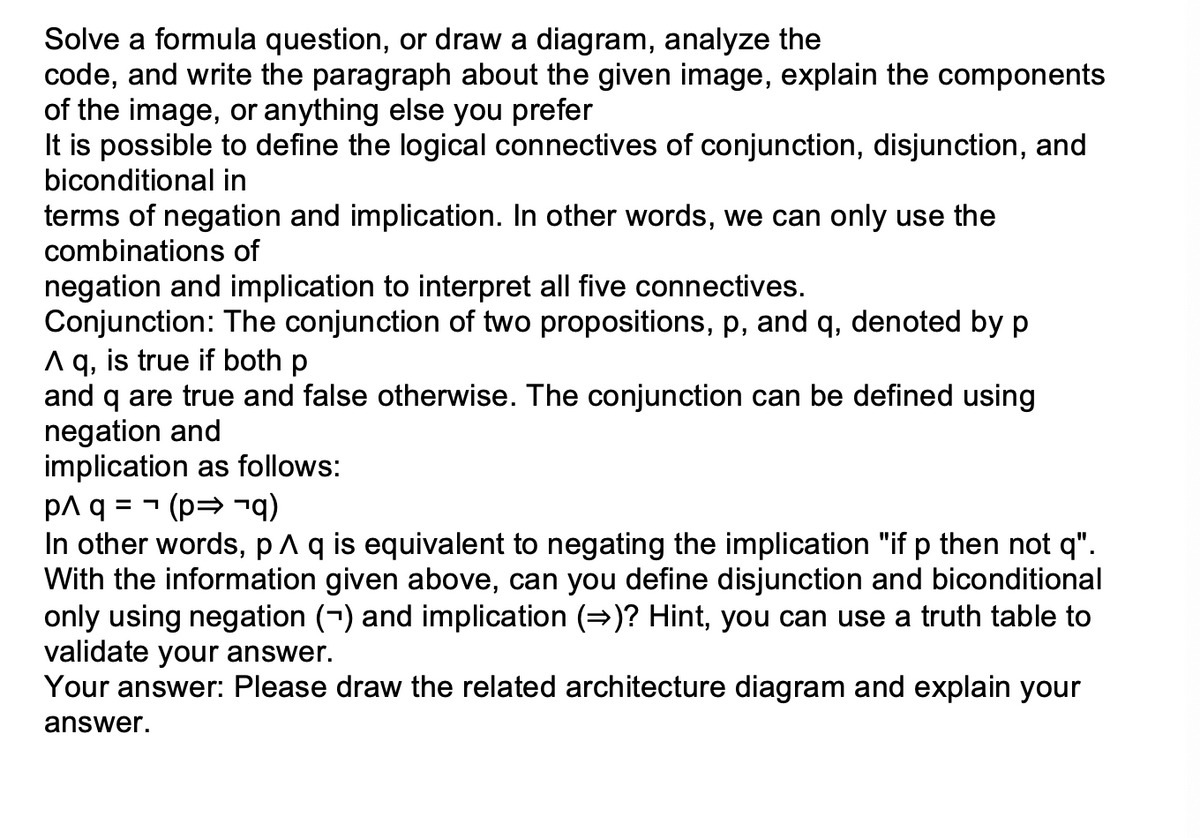Solve a formula question, or draw a diagram, analyze the code, and write the paragraph about the given image, explain the components of the image, or anything else you prefer It is possible to define the logical connectives of conjunction, disjunction, and biconditional in terms of negation and implication. In other words, we can only use the combinations of negation and implication to interpret all five connectives. Conjunction: The conjunction of two propositions, p, and q, denoted by p A q, is true if both p and q are true and false otherwise. The conjunction can be defined using negation and implication as follows: p^ q = (p⇒ q) 7 In other words, p ^ q is equivalent to negating the implication "if p then not q". With the information given above, can you define disjunction and biconditional only using negation () and implication (→)? Hint, you can use a truth table to validate your answer. Your answer: Please draw the related architecture diagram and explain your answer.
Solve a formula question, or draw a diagram, analyze the code, and write the paragraph about the given image, explain the components of the image, or anything else you prefer It is possible to define the logical connectives of conjunction, disjunction, and biconditional in terms of negation and implication. In other words, we can only use the combinations of negation and implication to interpret all five connectives. Conjunction: The conjunction of two propositions, p, and q, denoted by p A q, is true if both p and q are true and false otherwise. The conjunction can be defined using negation and implication as follows: p^ q = (p⇒ q) 7 In other words, p ^ q is equivalent to negating the implication "if p then not q". With the information given above, can you define disjunction and biconditional only using negation () and implication (→)? Hint, you can use a truth table to validate your answer. Your answer: Please draw the related architecture diagram and explain your answer.
Advanced Engineering Mathematics
10th Edition
ISBN:9780470458365
Author:Erwin Kreyszig
Publisher:Erwin Kreyszig
Chapter2: Second-order Linear Odes
Section: Chapter Questions
Problem 1RQ
Related questions
Question

Transcribed Image Text:Solve a formula question, or draw a diagram, analyze the
code, and write the paragraph about the given image, explain the components
of the image, or anything else you prefer
It is possible to define the logical connectives of conjunction, disjunction, and
biconditional in
terms of negation and implication. In other words, we can only use the
combinations of
negation and implication to interpret all five connectives.
Conjunction: The conjunction of two propositions, p, and q, denoted by p
A q, is true if both p
and q are true and false otherwise. The conjunction can be defined using
negation and
implication as follows:
p^ q = (p⇒¬q)
In other words, p ^ q is equivalent to negating the implication "if p then not q".
With the information given above, can you define disjunction and biconditional
only using negation (¬) and implication (→)? Hint, you can use a truth table to
validate your answer.
Your answer: Please draw the related architecture diagram and explain your
answer.
Expert Solution
This question has been solved!
Explore an expertly crafted, step-by-step solution for a thorough understanding of key concepts.
This is a popular solution!
Trending now
This is a popular solution!
Step by step
Solved in 4 steps with 4 images

Recommended textbooks for you

Advanced Engineering Mathematics
Advanced Math
ISBN:
9780470458365
Author:
Erwin Kreyszig
Publisher:
Wiley, John & Sons, Incorporated

Numerical Methods for Engineers
Advanced Math
ISBN:
9780073397924
Author:
Steven C. Chapra Dr., Raymond P. Canale
Publisher:
McGraw-Hill Education

Introductory Mathematics for Engineering Applicat…
Advanced Math
ISBN:
9781118141809
Author:
Nathan Klingbeil
Publisher:
WILEY

Advanced Engineering Mathematics
Advanced Math
ISBN:
9780470458365
Author:
Erwin Kreyszig
Publisher:
Wiley, John & Sons, Incorporated

Numerical Methods for Engineers
Advanced Math
ISBN:
9780073397924
Author:
Steven C. Chapra Dr., Raymond P. Canale
Publisher:
McGraw-Hill Education

Introductory Mathematics for Engineering Applicat…
Advanced Math
ISBN:
9781118141809
Author:
Nathan Klingbeil
Publisher:
WILEY

Mathematics For Machine Technology
Advanced Math
ISBN:
9781337798310
Author:
Peterson, John.
Publisher:
Cengage Learning,

